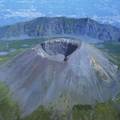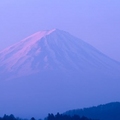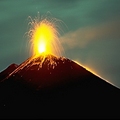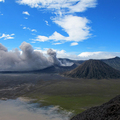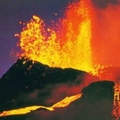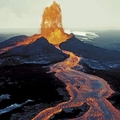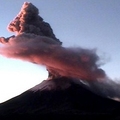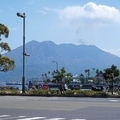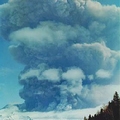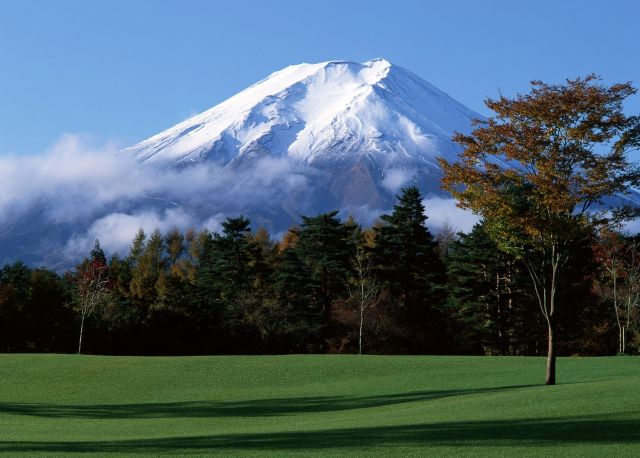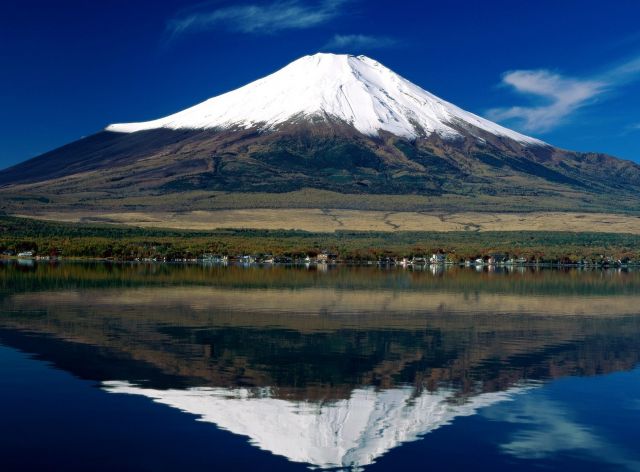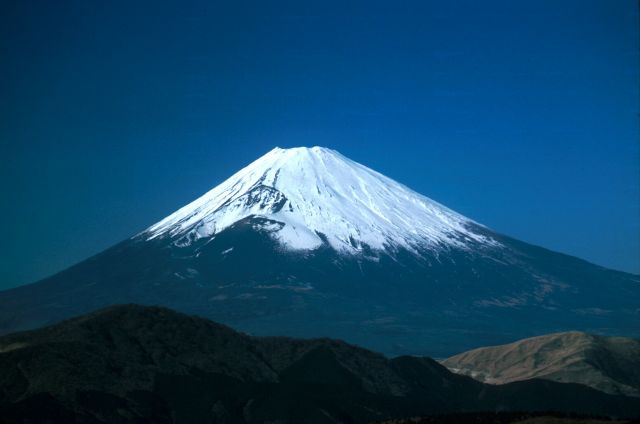Eco-friendly locations / The Best Volcanoes to Visit in the World / Fuji
Fuji
Mount Fuji, or Fuji-san, is the main symbol of Japan. For the inhabitants of the country it is sacred. Fuji is a dormant volcano. Respectfully called Fujisan, Fuji-no-yama and Fuji ("hole" from Japanese meaning "mountain") is one of the world's most famous volcanoes. It is located in the north of Honshu, near Tokyo, the National Park Fuji-Hakone-Izu. The height of the mountain is of 3776 m, the diameter of the crater reaches 610 meters. The last eruption of this volcano lasted from November 1707 to January 1708. The "Spirit of the Mountain" is still restless, therefore, carefully closely, you can see it at the same potential activity even in Tokyo. In fact, on the mountain there is not one but three volcanoes, but during one of the eruptions of Shin Fuji (" the new Fuji "), most of the traces of the old peak was strewn with rock. According to the legend, a place of power, the mysterious Mount Fuji appeared on the plain one night in 286 BC. It is considered the most mystical, the most mysterious and the most beautiful top in the country, so that appears in many Japanese legends, such as, for example, "History Taketori Monogatari." There are several versions of this tale, here is presented perhaps the most beautiful of them.
The legend
Long time ago, an old man and an old woman lived in the mystical town of Fuji. They wanted a child, but God didn’t hear their prayers. The old man was engaged in weaving baskets out of the bamboo, and one day, gone for a cane, he saw a girl lying in the thickets, having the size of a thumb of his hand. Full with immense joy, the old man took her home and raised her as his daughter, calling Kaguyahim, which means " The Shining Princess." The girl grew up and turned into a graceful, gentle girl, the finest in the neighborhood. Her hands sought many important people, including the emperor himself, and later a judge could not resist her charms. She was married to a judge who flunked her with expensive gifts. One day she told her husband that she wanted to go back to whence it came. She called this place "The Moon Palace", which was at the top of the Fuji Mountain. The judge did not want to part with his wife, so it forbade her journey, but one day, in a full moon night, she went there, breaking all taboos. The judge followed her up the hill. Climbing to the summit, he saw a large lake in the center of which a huge magnificent palace stood. Kaguyahim was there, but lost the human form, becoming a heavenly nymph. The messengers of the Moon came out to meet her, and put on her cloak of feathers, which made her forget her earthly life. After this, the envoys have taken away the beauty. The judge knew that he had lost his wife forever, and, unable to endure his grief, plunged into the deep lake. As the first most important miracle of nature in Japan, the Fuji Mountain has always been an important religious center. The combined efforts of Shinto-Buddhist sects (Fujiko) pilgrimage to the sacred mountain were a widespread tradition. The most zealous not only go up, but also make circumvention "of the eight peaks" at the top. The rise was carried out in ten stages with stops in which the travelers were provided with food and an opportunity to rest. At the fifth stop of believers could also bypass the mountain which was a particular stage of the pilgrimage. Currently, the rise of the hill is equally popular with tourists as well as many religious people. It is customary to take with you "a stick to climb the Mount Fuji," which at each stop, special marks are burned, as well as several security amulets. Various religious sects called the Fuji mountain sacred, some believe that, just as a faithful Muslim, one must visit Mecca. Every Japanese needs at least one day to ascend to the summit of the Fuji mountain. On the slopes of the mountain towards the ascension a great variety of churches scatter.
Japan's main attraction
Fuji is Japan's main attraction. In high season, from July to August, the mountain rises to 400 thousands of tourists. Their main desire is to see Fuji from the top of the sunrise. Fuji is a place of worship. Each year, climbing to its summit up to 10 thousand pilgrims are committed. The beauty of Fuji has inspired the most famous Japanese artists and poets, it is sung in many works of folk art. One of the most prominent artists, inspiring views of Mount Fuji, was Katsushika Hokusai (1760-1849). It is considered the most brilliant artist of the period from the mid 90s. XVIII century. Before the XIX century, it created a huge set (20 000) of paintings and colored engravings, which became the basis for Japanese traditions and legends. The most famous of his landscapes, including the "36 Views of Mount Fuji" was founded in 1827. The name of Mount Fuji in the hieroglyphic writing has changed over the years and had different meanings, including "Mountain warriors "and" knows no equal, "- these two historical interpretations deserve to be mentioned. In the language of the Ainu, "pound" means "Fire God" or "volcano" in Malay and "Fuji" - "beautiful." Mount Fuji is very shy: it always tries to close the clouds, but there are days when it can be seen from Tokyo . The excellent view of Mount Fuji can be enjoyed from the windows of the high-speed train from Hakone, and the lake at its foot. The Fuji Five Lakes district is a popular holiday destination. Admire Mount Fuji overlooking the spectacular trees of Tokyo.
Maps of Fuji
map JapanOthers from The Best Volcanoes to Visit in the World
A volcano is formed by a non-visible internal structure of the crust including magma chamber , magma pipes and a visible structure.
More commonly, the term volcano refers only to the outside and the visible part to the right of the volcanic relief , more or less conical, consisting of all those materials, liquid, solid or gaseous fuels, which were issued from the craters during the various stages of the eruption of the volcano itself.
The masses of rocks which form a volcano are called igneous rocks , as derived from the cooling of the magma ascended from the Earth .
The shape and the height of a volcano depend on several factors including the age of the volcano, the type of the eruptive activity, the type of the released magma and the characteristics of the underlying volcanic structure.
In general volcanoes are discontinuities in the Earth's crust through which all various events and magmatic endogenous products: powders, gases, vapors and solid volcanic material is casted.
The release of this material is erupting and the erupted materials are lava , ash , gas , slag and various water vapors .
On the surface, 90% are submarine volcanoes (mostly located along the dorsal mid-ocean), while about 1500 volcanoes are now active on land.
Description What is commonly called a volcano, technical terminology is defined in the volcano or volcanic cone , but since the term most used is the volcano.
The volcano is often named in geology .
The volcanoes testify to the existence, in the deep zones of the lithosphere , the molten masses of silicate are called natural magmas .
A generic volcano is formed by: a magma chamber or a magma basin, fed by magma , when it is empty after an eruption.
A volcano may collapse and create a caldera .
The magma chambers are located between 10 and 50 km depth in the lithosphere .
a stack or a duct volcanic main crossing point of the magma from the magma chamber to the surface.
a crater summit, where the main pipe flows.
one or more secondary ducts, which, flowing from the flanks of the volcano or the same basis, give life to the secondary cones.
lateral cracks, fractures on the longitudinal side of the volcano, caused by the pressure of the magma.
They allow the escape of lava in the form of eruption.
For their grandeur of the event the volcanoes are an object of admiration, of fear, of curiosity and of study since the antiquity with different interpretations created to explain its origin.
Plato admitted the existence of an underground river of fire.
Seneca indicated as the cause of eruptions and earthquakes, the penetration of water into the ground, when the water reached the incandescent matter, vapors under high pressure.
In 79 AD ,Pliny the Younger described the eruption of Vesuvius that buried Pompeii , Herculaneum and Stabiae.
But the real science that studies volcanoes, the volcanology ,was born only in the seventeenth century , when the naturalists were interested in the eruptions of Vesuvius ( in 1631 ) and of Etna ( in 1669 ).
This science is more decisive in progress with the studies of Spallanzani and then in the nineteenth century , with the help of petrography .
The origin of volcanoes is explained by various theories, including two important, but opposite theories: the theory of craters of lifting De Buch ; the theory of external accumulation of Scrope and Spallanzani .
In the theory of De Buch, volcanoes would have originated from the magma which would raise the outer layers of the Earth forming the cone, which then would break up to form the craters.
In the second theory, the volcanoes would be due to the accumulation of the solid material emitted or projected from the volcanic conduit.
The heat that is produced inside exerts a pressure evenly over the crust, thinner where the magma would surrender, letting it , causing the birth of the volcanoes.
The classification of volcanoes The volcanoes can be classified according to the type of external device or the type of the volcanic eruptions, both of these characteristics being closely linked to the composition of the magma and the magma chamber (and thus emitting lava).
This classification is called Lacroix Classification by the French geologist Alfred Lacroix who first conceived.
Depending on the type of the volcanic external apparatus Considering the type of the volcanic cone there are 2 types of volcanoes: 1.
Shield volcanoes 2.
Cone volcanoes Shield volcanoes A shield volcano has moderately sloping sides, and it is built by the eruption of the lava basalt fluid.
The basaltic lava tends to build enormous cones low slope, because its low viscosity allows it to slide smoothly on the ground or under it, in the lava tubes, up to many kilometers without significant cooling.
The major volcanoes of the world are the shield volcanoes.
The name comes from the same geometry, which makes them look like shields resting on the ground.
The largest shield volcano in the world is in Hawaii , its name is Mauna Loa .
It measures about 4000 m above the sea level , but its base is located at 5000 feet below the sea level, so its actual height is of 9000 meters, while its base diameter is about 250 km.
Cone volcanoes We find a volcano cone when the lava is acidic.
In these cases, the magma is very viscous and it is difficult to trace, solidifying quickly once outside.
Emissions flow and alternate with the solid material that is shot out and alternate with the cast, as the layers of the building.
The eruptions of this type can be very violent (like that of Vesuvius that buried Pompeii ), because the magma tends to obstruct the volcanic chimney creating a "cap" only when the internal pressures are sufficient to overcome the obstruction, the eruption resumed ( the eruption of Vulcan type), but in extreme cases there may be an explosion that may come to destroy the entire volcano ( Peleus).
The volcanism of this type is present along the continental margin of the pits or arc-trench systems, where the magma comes from the crust where the rocks are more of an exogenous composition.
Depending on the type of the eruptive activity Broadly speaking we distinguish red volcanoes (volcanoes characterized by effusive emissions in which the accumulation of the volcanic lava flows gives the building looks "reddish brown"), and gray volcanic (eruptions of volcanoes with explosive character in which the accumulation of ash give the building looks gray-black volcanic).
Specifically, considering the type and the power of the eruption of a volcano you have: 1.
Hawaiian volcanoes in eruption type 2.
Volcanoes in eruption of Icelandic type 3.
Strombolian volcanoes in eruption type 4.
Volcano eruption at Vulcan type 5.
Volcano eruption at Vesuvius type 6.
Plinian eruptions at volcanoes and Pelean type 7.
Large calderas ("super-volcanoes") Hawaiian Type The eruptions are not related to the tectonic movements that are due to the plaque but rather to see the phenomena the magma plumes from the back to warm up the hot spots.
The summit of the volcano is occupied by a large depression called caldera , bounded by steep walls due to the collapse of the fund.
Others occur within the caldera collapses, creating a well structure .
The lava is very basic and therefore very fluid, it produces the typical volcanic edifices form a "shield , with weak slopes of the mountains.
Icelandic type They are also called volcanic fissure eruptions which occur through long slits and not by a circular crater.
The casting, basic and the ultra basic magmas fed by, tend to form the highland basalt (basalt plateaus).
At the end of an eruption fissure (or linear), the eruptive fissure may disappear since it is covered by lava and solidified spill, does not reappear until the next eruption.
The best examples are found in Iceland , from which the special designation of the type, an excellent example of the Icelandic volcano eruption is that of Laki of 1783 , one of the most famous volcanic eruptions in the history of the European Union .
Strombolian type Very viscous basaltic magmas give rise to an enduring characterized by emissions at regular intervals and fragments of lava fountains that reach hundreds of meters high, and the launch of lava and volcanic bombs.
The fallout of these products creates scoria cones from the quite steepides .
Stromboli , the island-volcano from which it takes its name, this kind of effusive activity, has been in business for two millennia, much to be known, since the time of the earliest civilizations as the " lighthouse of the Mediterranean .
" Type Vulcan They were named after the island of Vulcano in the archipelago of the Aeolian Islands .
They are explosive eruptions during which lava bombs release clouds of gas and ash laden.
The explosions can produce fractures, ruptures of the crater and the opening of lateral vents.
Vesuvius type From the name of the volcano Vesuvius , it is similar to the Vulcan, but with the difference that the initial explosion is tremendously violent enough to drain most of the magma chamber: the magma from deep zones, then back up at high speed out of the crater and dissolve in tiny droplets.
When this type of eruption is at its most violent it is called Plinian eruption (in honor of Pliny the Younger who first described the course in 79 AD).
Plinian type The eruptions are produced by very viscous magma .
Hot clouds are frequently formed from gas and pulverized lava.
They are very dangerous eruptions ending usually with partial or total collapse of the volcano or the release of a plug of lava that of a volcanic plug or dome .
In some cases both phenomena occur.
The volcanic eruption that exhibits this behavior are characterized by the shape of a cone.
These eruptions are named for Pliny the Younger who first described this type of eruption observing the eruption of Vesuvius in 79 AD, which submerged Pompeii and Herculaneum in ashes .
A variant is the Plinian eruption : if during a Plinian eruption the main body of the glowing cloud released from the crater summit during an eruption peleana (which takes its name from the volcano 's Pelee in Martinique ) , the volcano erupts from the crater, but not centrally splitting up the side of the volcano.
This eruption has devastating effects concentrated in the direction of the main eruption of a glowing cloud that can reach more than 20 km from the building volcanic (as happened in 1980 in the eruption of St.
Helens ).
Other variants of the Plinian eruptions are the ultra-plinian : these eruptions are characterized for having an even bigger explosion, which may come to completely destroy the volcanic edifice (it is an example of the Krakatoa or Santorini ), and above all for the enormous amount of the released volcanic ash.
The explosion of this type, based on the large amount of ash that remains in suspension in the atmosphere, has a greater or lesser impact on the global climate in the years following the eruption.
Large calderas Although not recognized as true volcanoes, they deserve a separate mentioning: the case of 7-8 large calderas identified on the surface.
These structures are characterized by not having a volcano rather than a depression of volcanic origin (known as Caldera), which covers a vast area, more than 10-15 km.
Inside the caldera, you can see the development of various craters formed more or less.
It was never observed an eruption of this type of calderas (which have periods of eruption of hundreds of thousands of years) and these areas are now subject only to a minor type of volcanism (geysers, fumaroles, hot springs, .
.
.
).
The best known examples of this type of equipment is the park of Yellowstone , The Phlegraean Fields , the Alban Hills , the Toba Lake .
Activities of volcanoes The magma rises through the mantle or less dense than the Earth's crust because of the surrounding rocks (lifts for buoyancy ).
During the ascent, due to the decrease in pressure , the gases dissolved in the melt dissolve a further decrease of the density .
The magma in the crust can build up, to cool and solidify, or climb up to the surface of the earth thus giving rise to an eruption .
The eruptions may be of different types: they can give rise to explosive phenomena, where ash and lapilli are projected up to tens of kilometers above the crater and deposited up to hundreds of miles away from the eruptive center, or effusive, if the magma flows, forming a lava flow that propagates to shorter distances (tens of meters to a few km from the eruptive center).
One of the characteristics that influences the type of the eruption is the viscosity of the magma, which depends on the content of silicon , which binds with the oxygen molecules that form always tend to bond with each other and form indestructible chains.
If the magma has more than 60% silica [SiO2] it is considered viscous and more likely to give rise to an explosive eruption, but if the magma has less than 50% silica it is likely to be erupted with dynamic and effusive emitted lava as flows.
Here is a presentation of the most famous and the most popular volcanoes in the world.
Of course, I referred to their power of eruption, their activity and their beautiful environment provided to visitors.
Volcanoes represent huge interest to people, not only for the fact that they are dangerous but for many other reasons too.
Discover the most famous volcanoes in the world.

